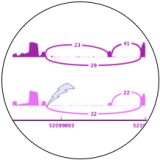The MacArthur lab uses cutting-edge genomic technologies at massive scale to understand the impact of human genetic variation, and to provide answers to families affected by rare genetic diseases.
The MacArthur lab has now moved to Australia! Daniel now directs the new Centre for Population Genomics, based jointly at the Garvan Institute of Medical Research in Sydney and the Murdoch Children’s Research Institute in Melbourne.
 |
genomic data aggregation Our team led an international consortium that assembled gnomAD, the world’s largest single collection of sequencing data from human genome sequencing data, currently spanning 141,456 individuals. We’ve mined this massive dataset for insights into disease variant interpretation, gene discovery, and drug target validation. Read more → |
 |
rare disease gene discovery We’ve developed and applied genomic technologies, including exome, whole-genome and RNA sequencing, to improve the diagnosis of rare Mendelian diseases, with a particular focus on neuromuscular disorders. Our tool seqr is an intuitive online portal for exploring exome and whole-genome sequencing data from rare disease families. Read more → |
 |
using gene expression data to interpret variation Transcriptomic data provide powerful insights into the effects of genetic variation on gene expression and splicing. We use RNA sequencing (RNA-seq) data from muscle disease patients and from hundreds of reference samples to improve variant interpretation. Read more → |
 |
loss-of-function variation Loss-of-function (LoF) variants – genetic variations that destroy the normal function of protein-coding genes – are useful guides to disease gene identification and therapeutic target discovery. We are building new tools for discovering LoF variants, and exploring their impact on the phenotypes of tens of thousands of people. Read more → |